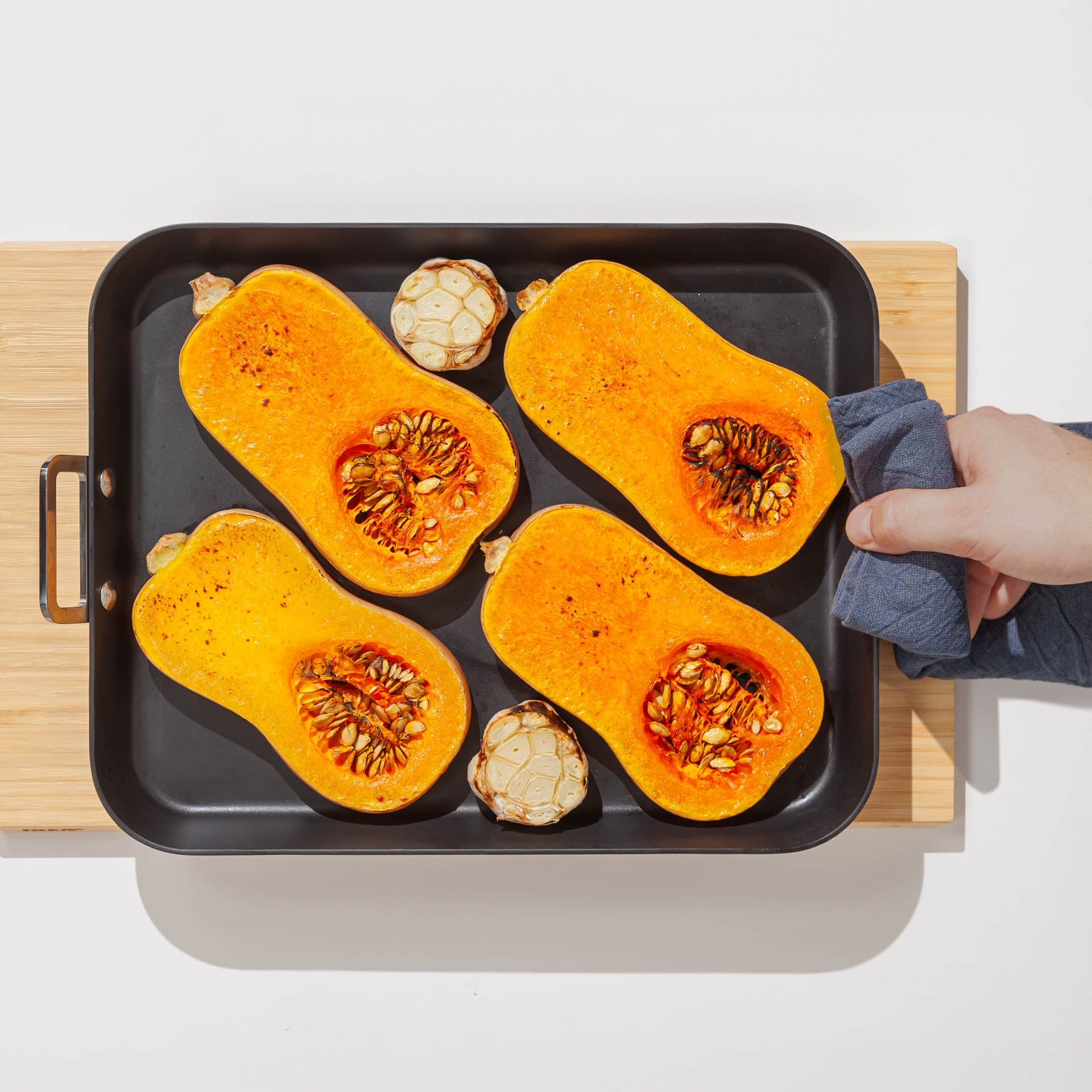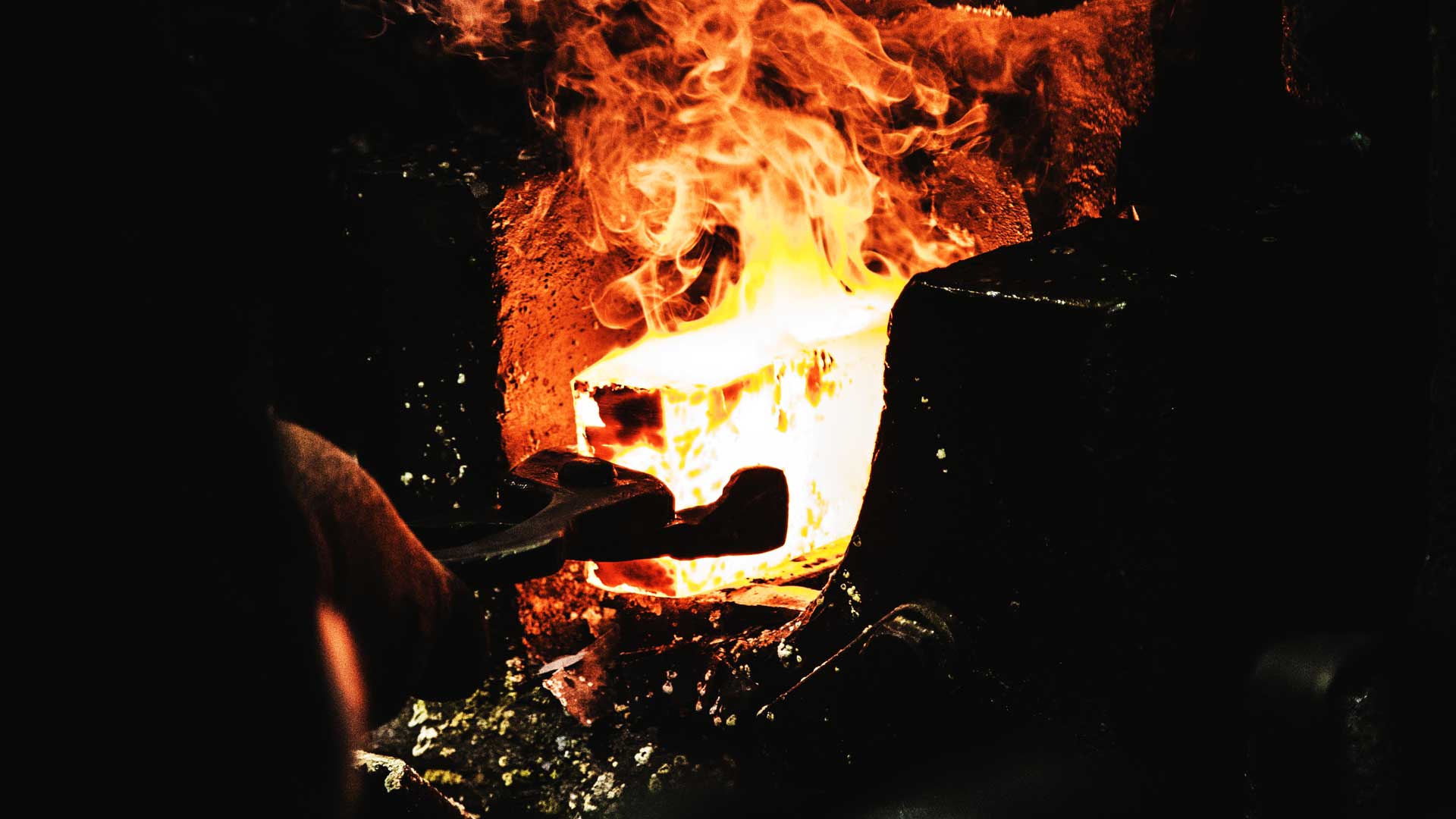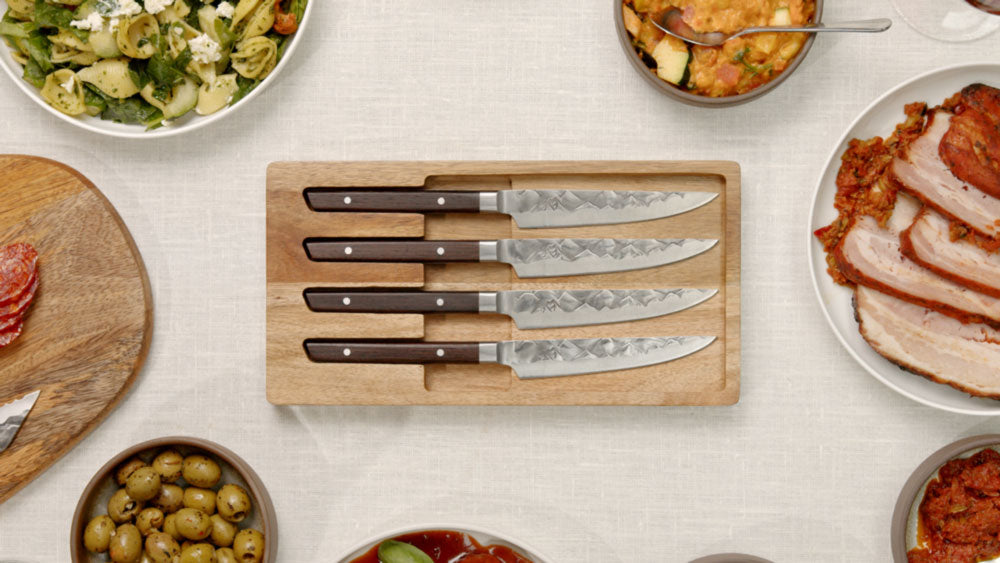Zoals een schilder een penseel heeft, heeft een kok een mes. Van al het keukengerei dat je ooit zult bezitten, is niets zo onmisbaar als een goed mes. De meeste chef-koks hebben een scala aan messen om uit te kiezen. Maar als je er maar één mocht kiezen, zou het koksmes de beste keuze zijn. Dat we 11 snijtechnieken op een rij hebben kunnen zetten, zegt iets over de veelzijdigheid van het koksmes.
Met dit ene mes kun je alles snijden of fijnhakken, van een malse steak tot verse groenten. Of je nu een beginnende kok of een ervaren kok bent, het belangrijkste stuk kookgerei dat je tot je beschikking hebt, is je koksmes.
Dus wat zijn dingen die je kunt doen met een koksmes? Laten we enkele voorbeelden noemen! Oh, en zorg ervoor dat je onze handleiding raadpleegt hoe je het mes veilig vasthoudt.
DE CHEF
Duidelijk! De meest eenvoudige snijtechniek is de ‘Chef’s chop’. Plaats de punt van het mes op de snijplank en duw het mes door het product. Til tijdens het terughalen op en herhaal. Het kost wat tijd om deze techniek onder de knie te krijgen, maar is essentieel in elke keuken.
HAKKEN
Beweeg het mes eenvoudig op en neer. Het platte gedeelte van het lemmet bij het handvat is perfect voor het hakken. Deze techniek geeft een mooie rechte snede. Een meer klassieke aanpak is om het mes tegelijkertijd een beetje heen en weer te bewegen, zodat je diagonaal snijdt.
WIEGEN
Wiegen doe je door je vrije hand op de rug van het mes te plaatsen voor extra controle en veiligheid. Door de opwaartse buiging richting de punt van het koksmes kun je de handgreep omhoog tillen zonder dat het lemmet de snijplank verlaat. Het mes van hiel tot punt heen en weer bewegen is perfect voor het fijnsnijden van verse kruiden. Het is ook een veilige manier van snijden voor harde groenten zoals zoete aardappelen.
JULIENNE & BRUNOISE
De julienne-snijtechniek is synoniem aan high-end keukens. Hoewel dit niet het gemakkelijkste is om constant uit te voeren, kom je met een scherp mes al een heel eind. Wanneer u gelijkmatige reepjes of blokjes snijdt, kunt u de zijkant van het mes gebruiken om uw werk recht te maken. Dit geeft u een duidelijk referentiepunt om te beginnen met snijden of hakken, terwijl u stukken van gelijke grootte behoudt.
SCHILLEN
Ja, zelfs schillen kan met een koksmes. Toegegeven: de dunschiller werkt vaak beter. Maar als u in de knel zit, kunt u uw hand van het handvat naar het lemmet van het mes bewegen om meer controle te krijgen. Dit vergt enige vaardigheid. Als het goed wordt gedaan, levert het een zeer rechte snede op. Bijvoorbeeld bij het schillen van een komkommer.
FILEREN
De spitse punt en het gebogen uiteinde van het lemmet van het koksmes zijn perfect voor het fileren van vis of het ontbenen van vlees of gevogelte. Vissen kunnen zelfs worden ontveld door het mes plat te leggen.
SCORE
De scherpe puntige punt van het koksmes is perfect voor het prikken en inkerven. Bij het grillen van zalm levert het inkerven van de huid bijvoorbeeld een knapperiger resultaat op. Om de zalmhuid in te snijden, plaatst u het mes bijna recht omhoog. Duw het mes naar beneden totdat de huid van de vis net doorboord is. Ga niet te diep. Sleep vervolgens de punt van het mes naar u toe om de huid te kerven, waarbij u de snede ondiep houdt.
FIJNHAKKEN
Steak tartaar? Zalmtartaar? Gehakt? Ja, het kan met een koksmes! Gebruik voor een fijn gehakt een weig snede. Blijf eenvoudig met het mes wiegen totdat het resultaat zo fijn of grof is als je wilt. Voor een meer klassieke tartaar gebruik je een snijtechniek om kleine, gelijkmatige blokjes vlees of vis te krijgen.
PLETTEN
Ja! Een koksmes beperkt zich niet enkel tot snijden. De zijkant van het mes is perfect om mee te pletten! Vooral handig voor knoflook en gember. Plaats het mes eenvoudig plat op een teentje knoflook en sla/duuw op de zijkant van het mes. Veel sneller dan een knoflookpers. En je hebt minder om schoon te maken.
KNEUZEN
De meeste aromaten en kruiden hebben er baat bij als ze worden gekneusd, zodat er meer smaak vrijkomt. Hiervoor gebruiken we de achterkant (of rug) van het mes. Bijvoorbeeld: om citroengras te kneuzen, hoeft u alleen maar een paar keer met de rug van het mes op het citroengras te slaan om het zacht te maken. Hetzelfde geldt voor rozemarijn, salie, gember, knoflook.. noem maar op!
MALEN
Zelfs het malen van harde kruiden kan met een koksmes. Gebruik de zijkant van het blad als molensteen. Om bijvoorbeeld peper fijn te malen, plaats je het mes plat op de peperkorrels. Duw hard op de zijkant van het mes en beweeg het handvat heen en weer om de korrels te verpletteren. Een truc die je bij deze techniek kunt gebruiken, is door wat zout als schuurmiddel toe te voegen om het proces te versnellen. We hebben ontdekt dat het smeedpatroon op de zijkant van onze messen perfect is voor deze techniek.
Net zoals voedsel zoveel meer is dan brandstof, is een koksmes zoveel meer dan een mes. Een geweldig mes voelt precies goed en is in balans. Het blijft scherp. Het ziet er goed uit. Je zorgt er met liefde voor. Een goed mes heeft een ziel.
BARE Cookware gaat over die ziel. Omdat we kookgerei willen maken dat lang meegaat. Dat inspireert je om beter te koken. BARE Knives gaat over vakmanschap. Want messen maken is een kunst. Net als koken. Eenvoudig, maar moeilijk om te perfectioneren.
Deze lijst met snijtechnieken is zeker niet volledig, we hebben er waarschijnlijk een paar gemist. Hoewel een koksmes veelzijdig is, zijn sommige taken beter geschikt voor gespecialiseerde messen. Wilt u meer lezen over specifieke messentypes? Lees hier verder.







Laat een reactie achter
Alle reacties worden gemodereerd voordat ze worden gepubliceerd.
Deze site wordt beschermd door hCaptcha en het privacybeleid en de servicevoorwaarden van hCaptcha zijn van toepassing.